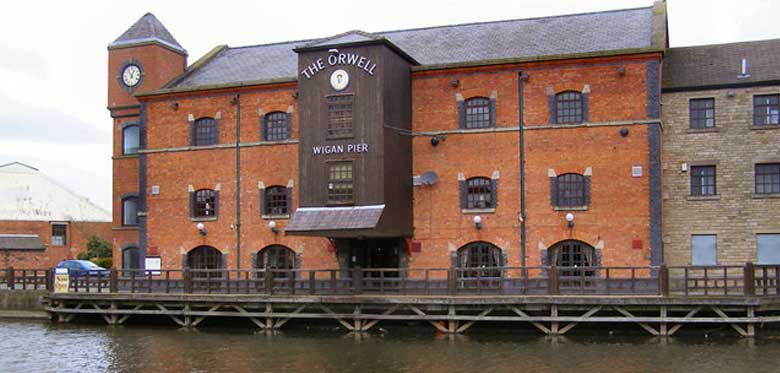It is now 80 years since George Orwell’s famous book was published on 8th March 1937. The author’s son, Richard Blair, will visit the town as part of a programme of events to celebrate its links with one of the most important writers of the 20th century. Mr Blair will answer questions during a talk at the Museum of Wigan Life. The museum building, designed by Alfred Waterhouse, was originally a reference library where Orwell did lots of his research for the book. Orwell signed the library visitor’s book under his real name, Eric Blair.
It is probably fair to say that The Road to Wigan Pier has a somewhat mixed reception in the town, as it highlights the terrible living conditions faced by working class residents of the town during the 1930s. In the book, Orwell describes what he saw from the canal side.
"All round was the lunar landscape of slag-heaps, and to the north, through the passes, as it were, between the mountains of slag, you could see the factory chimneys sending out their plumes of smoke. The canal path was a mixture of cinders and frozen mud, criss-crossed by the imprints of innumerable clogs, and all round, as far as the slag-heaps in the distance, stretched the ‘flashes’ — pools of stagnant water that had seeped into the hollows caused by the subsidence of ancient pits. It was horribly cold. The flashes were covered with ice the colour of raw umber, the bargemen were muffled to the eyes in sacks, the lock gates wore beards of ice. It seemed a world from which vegetation had been banished; nothing existed except smoke, shale, ice, mud, ashes, and foul water."
Thankfully much has changed since this negative Orwellian impression of the area was read far and wide! Stephensons’ Wigan office is located a short walk away from Wigan Pier and next to the Leeds & Liverpool Canal. The ongoing aim is to fully regenerate this area of the town which now offers business conferencing facilities and a very popular coffee shop called Postcode. The construction of a 1200 seater performance venue is well underway in what is now known as the ‘Pier Quarter’. Sadly the pub which bears the author’s name is closed and currently there are no plans to re-open the former grain warehouse.
"If there is one man to whom I do feel myself inferior, it is a coal-miner"
Orwell clearly admired and respected the miners for the very difficult work they did and he went down the pits to witness it first-hand. He noted that the electric powered cutters created ‘clouds of coal dust which make it impossible to see more than two to three feet and almost impossible to breathe.’ Not all of the miners had access to pit head baths at the time and most didn’t have access to running hot water in their Victorian lodgings.
Stephensons currently act on behalf of former miners who were employed from the 1950s onwards in local collieries such as John Pit (Standish), Garswood Hall (Ashton), Maypole (Platt Bridge) and Wigan Junction (Abram). Our clients are suffering from ill health during their retirement simply for doing their jobs and having played such an important part in the area’s industrial past, we are proud to assist them with compensation and benefits advice. Please do get in touch with our industrial disease department if you know of any friends or family members who could be eligible as we are keen to ensure that claimants are legally represented in such matters to help achieve the best possible outcomes for them.



Comments